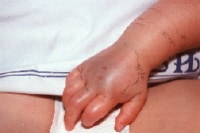- Keep in mind the snake appearence:
- Dealing with the victum :
While waiting for emergency call response:
- Move the person beyond striking distance of the snake.
- Have the person lie down with wound below the heart.
- Keep the person still to keep venom from spreading.
- Cover the wound with loose, sterile bandage.
Do not:
- Cut a bite wound
- Attempt to suck out venom
- Apply tourniquet, ice, or water
- Give the person alcohol or caffeinated drinks
- Follow Up
Contact a health care provider. The person may need a tetanus shot. Tetanus boosters should be given every 10 years.
- At the hospital, treatment will depend on the type of snake.
- If the snake was venomous, the person will be given anti-venom treatment.
- A tetanus shot may be given, depending on date of last injection.
- Emergency Department Care
 Regional centers often have more experience in the care of snakebite victims. Surgical evaluation for an envenomation victim is paramount.
Regional centers often have more experience in the care of snakebite victims. Surgical evaluation for an envenomation victim is paramount. Definitive treatment includes reviewing the ABCs and evaluating the patient for signs of shock (eg, tachypnea, tachycardia, dry pale skin, mental status changes, hypotension).
Evenomation grading determines the need for antivenin in victims of pit viper envenomations. Grades are defined as mild, moderate, or severe.
Mild envenomation is characterized by local pain, edema, no signs of systemic toxicity, and normal laboratory values.
Moderate envenomation is characterized by severe local pain; edema larger than 12 inches surrounding the wound; and systemic toxicity including nausea, vomiting, and alterations in laboratory values (eg, decreased hematocrit or platelet count). Moderate envenomation is shown in the image below.Snakebite. Moderate rattlesnake envenomation in a toddler after treatment with antivenom. Photo by Sean Bush, MD.
Severe envenomation is characterized by generalized petechiae, ecchymosis, blood-tinged sputum, hypotension, hypoperfusion, renal dysfunction, changes in prothrombin time and activated partial thromboplastin time, and other abnormal test results defining consumptive coagulopathy.
Grading envenomations is a dynamic process. Over several hours, an initially mild syndrome may progress to a moderate or even severe reaction.
Horse-serum antivenin has been available since 1956; a purer antivenin with improved properties was released in 2000 (see Medication). With the reduced side-effect profile of antigen-binding fragment antivenom (FabAV) and the improvement in tissue injury with antivenin administration, the threshold for dosing is lower. One study from the southwest United States demonstrated a reduction in rate of fasciotomy after more liberal FabAV dosing.[7] In a randomized study of scheduled versus as-needed FabAV dosing in patients whose symptoms were worsening, the Rocky Mountain Poison and Drug Center demonstrated a reduction in pain and other venom effects but noted a 20% acute and 23% delayed drug reaction.[8]
Although copperhead bites are generally self-limiting, morbidity was reduced in moderate envenomation 4 hours after 4 vials of FabAV in 88% of cases. The cases that failed to respond were not changed by further FabAV doses.[9]
FabAV is generally considered safe for children, as many of the studies did not discriminate in age. One large study from Mexico demonstrated no immediate or late allergic reactions to FabAV when administered according to grade of envenomation.[6]
Give antivenin for coral snakebites as a standard of care if the patient presents within 12 hours of the bite, regardless of local or systemic signs. Neurotoxicity may develop without warning and lead to respiratory failure.
Although FabAV helps control local tissue effects and hemotoxicity, aggressive antivenom therapy does not usually ameliorate neurotoxic effects such asmyokymia (spontaneous, fine fascicular contractions of muscle without muscular atrophy or weakness) and major muscle fasciculations. The physician must maintain continuous monitoring of those patients with myokymia especially of the shoulders, chest, and diaphragm for the development of respiratory failure and need for mechanical ventilation.[10, 11]
refference:
http://emedicine.medscape.com/article/168828-treatment
http://firstaid.webmd.com/snakebite-treatment

Hi, I do believe this is an excellent web site. I stumbledupon
ReplyDeleteit ;) I am going to revisit yet again since i have saved as a favorite it.
Money and freedom is the best way to change, may you be rich and continue to help other people.
Here is my web blog ... x ray technician wiki